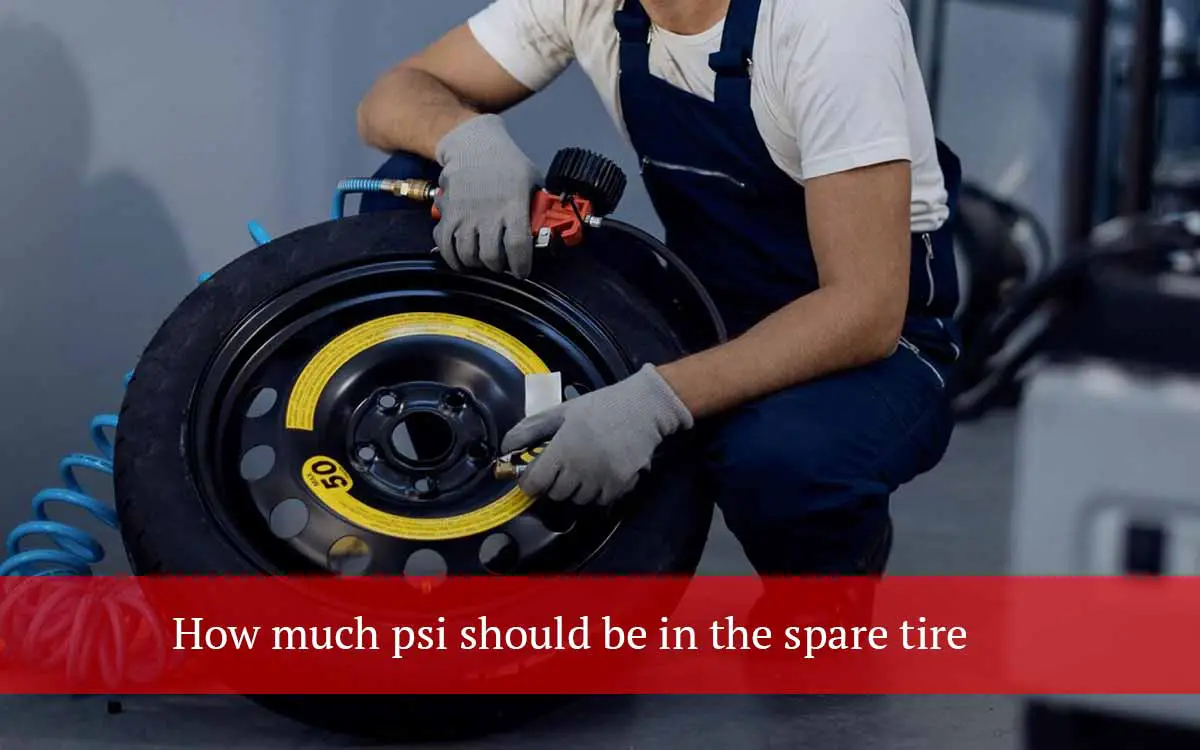How much air should be in your spare tire? This is a question that a lot of people don’t think about until they are in the middle of nowhere and their tire goes flat. If you are ever stranded on the side of the road, you will want to know how to properly inflate your spare tire. In this article, we will discuss how much PSI should be in your spare tire, how to use a tire pressure gauge, and some tips for changing a flat tire.
So to answer the question of How much PSI should be in the spare tire? The answer is that it depends on the make and model of your tire, However, it is typically around 50-60 psi. Most vehicles will have a sticker on the inside of the driver’s door that will tell you how much PSI should be in each tire, including the spare.
If you can’t find this sticker, you can usually find the information in your owner’s manual.
The sticker on your door is there to give you information about your vehicle. It will tell you the recommended tire pressure for each tire, including the spare. The recommended tire pressure is the amount of air that should be in each tire when it is cold. This means that if you have been driving for a while and the tires are warm, they will be slightly inflated. This is why it is important to check your tire pressure when the tires are cold.
If the sticker on your door says 32 PSI for the front tires and 35 PSI for the rear tires, this means that when the tires are cold, they should have 32 PSI of air in them. If the spare tire is a different size than the other tires, it will have a different PSI. For example, if your front tires are P215/60R16 and your rear tires are P225/60R16, the spare tire might be P205/65R15. This means that the spare tire will require a different amount of air pressure such as 30 PSI.
It is important to remember that the recommended tire pressure is for when the tires are cold. This means that you should check your tire pressure when the vehicle has been sitting for at least three hours or hasn’t been driven more than a mile. If you have been driving around all day, the tires will be warm and will be inflated. You should let the tires cool down before checking the pressure.
The sticker on your door will also tell you the maximum tire pressure for all your tires. This is the most air that should be in your tires, even when they are cold. If you inflate your tires to the maximum tire pressure, it could make your ride uncomfortable and cause your tires to wear down faster.
Now that we know how much PSI should be in the spare tire, let’s talk about why spare tires have a higher psi.
Why do spare tires have a higher psi?
Spare tires usually have a higher psi because they are smaller than the other tires on the vehicle. This means that they need more air pressure to support the weight of the vehicle. Higher psi also helps to prevent flats.
It is important to remember that you should only use your spare tire for a short period. Once you get to where you are going, you should have the tire repaired or replaced as soon as possible. Driving on a spare tire for too long can cause problems and can even damage your vehicle.
How to check your spare tire pressure
The best way to check your tire pressure is with a tire pressure gauge. A Tire pressure gauge consists of a metal or plastic body with a small rubber tip. The gauge has a needle that moves to show how much air is in the tire. Tire pressure gauges are relatively cheap and can be a lifesaver if you ever have a flat tire. You can find these at most auto parts stores.
How to use a tire pressure gauge
To use a tire pressure gauge, unscrew the cap from your tire valve and place the end of the gauge on the valve. Make sure that you don’t push down on the gauge too hard or you could damage the valve. Once the gauge is attached to the valve, the air will start to escape from the tire and the gauge will give you a reading.
The reading on the gauge is given in PSI (pounds per square inch). If the reading is in bar, multiply it by 14.50377 to get the PSI. For example, if the reading on the gauge says that the pressure is at 21 bar, this is equal to 305 PSI.
If the reading on the gauge is too high or too low, you will need to add or release air from the tire until it reaches the proper pressure. To add air to the tire, use a portable air compressor or take it to a gas station that has an air pump. To release air from the tire, use the tire pressure gauge to release a small amount of air at a time until you reach the proper pressure.
It is important to check your tire pressure regularly, especially if you are going on a long road trip. Flat tires are one of the most common reasons for breakdowns and can be easily avoided by maintaining proper tire pressure.
If you don’t have a tire pressure gauge, you can usually find one at a gas station. Most gas stations have air pumps that also have a tire pressure gauge attached. You can use this to check your tire pressure and add air if needed. Just be sure to put the correct amount of air in your tires. too much air in your tires can be just as bad as not enough air.
When you are checking your tire pressure, be sure to also check the condition of your tires. Look for any cracks, cuts, or other damage. If you see anything that looks damaged, it is best to take it to a professional to have it looked at. Driving on damaged tires can be dangerous and can cause a blowout.
Tips on how to change a flat tire
There are a few things you should know before you attempt to change a flat tire.
Tools and materials needed
-Jack
-Lug wrench
-Spare tire
-Tire pressure gauge
Instructions
1. Park in a safe place
Park your vehicle on a level surface and turn off the engine. Make sure that you are parked far away from traffic and that your vehicle is in park before you begin. If you have a manual transmission, put the vehicle in first gear or reverse before you jack it up. This will help to prevent the car from rolling while it is lifted. If you have an automatic transmission, put the vehicle in park and set the parking brake before you begin.
2. Loose nuts
Before you start to jack up the car, loosen the lug nuts on the flat tire with the lug wrench. You will need to do this so that you can remove the tire after it is lifted off of the ground.
3. Jack up the car
Place the jack under the vehicle and raise it until the flat tire is lifted off of the ground. You will want to place the jack on a solid part of the frame so that it doesn’t slip while you are lifting the car. Once the tire is lifted off of the ground, remove the lug nuts and set them aside.
4. Remove the flat tire
Pull the flat tire off of the wheel and set it aside. Be careful not to damage the wheel when you are removing the tire.
5. Install the spare tire
Put the spare tire on the wheel and hand-tighten the lug nuts. Do not use the wrench to tighten them at this point. You will want to wait until the tire is on the ground before you tighten them all the way.
6. Lower the car
Once the spare tire is installed, lower the car back down to the ground. Be sure to do this slowly so that you don’t damage the jack or the car.
7. Tighten lug nuts
Once the car is back on the ground, use the lug wrench to tighten the lug nuts. Be sure to tighten them as much as possible so that they don’t come loose while you are driving.
8. Check tire pressure
The last thing you will want to do is check the tire pressure. Make sure that the spare tire has enough air and that the other tires on the vehicle are at the correct pressure.
Now you know how to change a flat tire! Be sure to practice so that you are prepared if you ever have to do it for real. Knowing how to change a tire can be a lifesaver, so it is worth taking the time to learn.
Final Thoughts
As mentioned earlier the amount of psi in a spare tire can vary depending on the size of the tire. It is important to check your owner’s manual to see what is recommended for your vehicle. You should also check the spare tire periodically to make sure that it has enough air pressure.
If you ever have a flat tire, remember to follow the steps above to change it safely. Be sure to drive carefully until you can get the tire repaired or replaced. Do not forget to check the pressure in all of your tires, including the spare, before you hit the road again.
Thank you for reading! I hope this article was helpful. If you have any questions, please feel free to leave a comment below. If you enjoyed this article, please share it with your friends or on social media. Thank you for reading! 🙂

